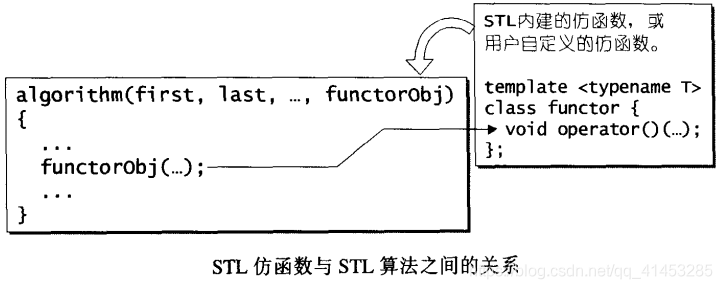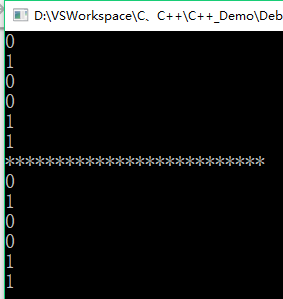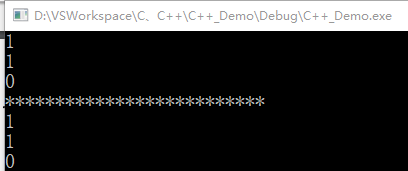一、仿函数概述
- 仿函数(functors)是早期的命名,C++标准规则定案后所采用的的新名称是函数对象(function objects)
- 仿函数的作用是什么?从前面的算法解析可以看出,有的算法提供第二个版本,该版本提供允许用户指定任何“操作”,然后以该操作来决定算法的执行功能。将这种“操作”当做算法的参数,先将该操作设计为一个函数,再将函数指针当做算法的一个参数或者将该“操作”设计为一个所谓的仿函数(就语言层面来说是个class),再以该仿函数产生一个对象,并以此对象作为算法的一个参数
- 上面提到,既然函数指针可以达到“将函数当做算法的参数”,那又为什么设计仿函数呢?是因为函数指针不能满足STL对抽象性的要求,也不能满足软件积木的要求——函数指针无法和STL其他组件(如配接器adapter)搭配,产生更灵活的变化

仿函数就是一个“行为类似函数”的对象
- 为了能够达到“行为类似函数”的目的,其类型定义中必须自定义(或者说重载、改写)function call运算子(operator())
- 拥有这样的运算子后,我们就可以在仿函数的对象后面加上一对小括号,以此来调用仿函数所定义的operator()
- 例如下面就是调用STL提供的greater仿函数:
- 第一种用法是产生一个名为id的对象,然后调用其operator()
- 第二种调用方式是产生一个临时(无名的)对象,然后调用其operator()。这种方式才是仿函数的主流用法
#include <iostream>
#include <functional>
using namespace std;
int main()
{
greater<int> ig;
std::cout << boolalpha << ig(4, 6) << std::endl;
std::cout << greater<int>()(6, 4) << std::endl;
return 0;
}
//boolalpha是把bool值显示为true或false

仿函数的分类
- 以操作符划分:分为一元仿函数与二元仿函数(没有其他的了)
- 以功能划分:分为算术运算、关系运算、逻辑运算
- 应用层头文件为:<functional>;STL源码实现于<stl_function.h>
二、可配接的关键
- 在STL六大组件中,仿函数是体积最小、实现最容易的一种。而仿函数扮演着一种“策略”角色:
- ①可以让STL算法有更灵活的演出
- ②更加灵活的关键在于STL仿函数的可配接性
- 仿函数可以让函数配接器(function adapter,见后面介绍)修饰,彼此串接在一起。为了拥有配接能力,每一个仿函数必须定义自己的相应类型:
- 这些类型是为了让配接器能够取出,获得仿函数的某些信息。相应的类型都只是一些typedef,所有必要操作在编译器就能全部确定
- 仿函数的相应类型主要用来表现仿函数参数类型和返回值类型
- 这就类似于迭代器如果想要融入STL,迭代器定义了自己的5个相应类型
- 为了方便起见,<stl_function.h>中定义了两个类,分别代表一元仿函数和二元仿函数,其中没有任何data members或member functions,唯有一些类型定义
- 对于仿函数,只要根据个人需要选择继承其中一个就可以了,便自动拥有了那些相应类型,也就自动有用了配接能力
unary_function
- unary_function用来表现一元函数的参数类型和返回值类型
- 其定义如下:
//STL规定,每一个Adaptable Unary Function都应该继承这个类
template <class Arg, class Result>
struct unary_function {
typedef Arg argument_type; //参数类型
typedef Result result_type; //返回值类型
};
- 一旦某个仿函数继承了unary_function,其用户就可以取得该仿函数的参数类型,或其返回值类型(下面未显示):
//此仿函数继承于unary_function
template<class T>
struct negate :public unary_function<T, T>{
T operator()(const T& x)const { return -x; }
};
//以下配接器用来表示某个仿函数的逻辑负值
template<class Predicate>
class unary_negate
{
//...
public:
//通过typename获得其中的参数类型
bool operator()(const typename Predicate::argument_type& x)const {
//...
}
//...
};
binary_function
- binary_function用来表现二元函数的参数类型和返回值类型
- 其定义如下::
//STL规定,每一个Adaptable Binary Function都应该继承这个类
template <class Arg1, class Arg2, class Result>
struct binary_function {
typedef Arg1 first_argument_type; //第1个参数的类型
typedef Arg2 second_argument_type; //第2个参数的类型
typedef Result result_type; //返回值类型
};
- 一旦某个仿函数继承了binary_function,其用户就可以取得该仿函数的参数类型,或其返回值类型(下面未显示):
//此仿函数继承于binary_function
template<class T>
struct plus :public binary_function<T, T, T>{
T operator()(const T& x, const T& y)const { return x + y; }
};
//以下配接器用来将某个二元仿函数转换为一元仿函数
template<class Operation>
class binder1st
{
//...
protected:
Operation op;
typename Operation::fist_argument_type value; //将其参数1类型,别名为value
public:
//下面是operator()的定义
typename Operation::result_type
operator()(const typename Operation::second_argument_type& x)
{
//...
}
//...
};
四、算术类(Arithmetic)仿函数
- STL内建的“算术类仿函数”,支持加法、减法、乘法、除法、模数(余数)、和否定运算
- 除了“否定”运算为一元运算,其余都是二元运算
- 包含如下:
- 加法:plus<T>
- 减法:minus<T>
- 乘法:multiplies<T>
- 除法:divides<T>
- 模取(modulus):modulus<T>
- 否定(negation):negate<T>
- 例如下面的代码表示要以1位基本元素,对vector中的每一个元素进行乘法运算:
accumulate(iv.begin(), iv.end(), multiplies<int>());
源码如下:
template <class T>
struct plus :public binary_function<T, T, T> {
T operator()(const T& x, const T& y)const { return x + y; }
};
template <class T>
struct minus :public binary_function<T, T, T> {
T operator()(const T& x, const T& y)const { return x - y; }
};
template <class T>
struct multiplies :public binary_function<T, T, T> {
T operator()(const T& x, const T& y)const { return x * y; }
};
template <class T>
struct divides :public binary_function<T, T, T> {
T operator()(const T& x, const T& y)const { return x / y; }
};
template <class T>
struct modulus :public binary_function<T, T, T> {
T operator()(const T& x, const T& y)const { return x % y; }
};
template <class T>
struct negate :public unary_function<T, T> {
T operator()(const T& x)const { return -x; }
};
演示案例
#include <iostream>
#include <functional>
using namespace std;
int main()
{
plus<int> plusobj;
minus<int> minusobj;
multiplies<int> multipliesobj;
divides<int> dividesobj;
modulus<int> modulusobj;
negate<int> negateobj;
std::cout << plusobj(3, 5) << std::endl;
std::cout << minusobj(3, 5) << std::endl;
std::cout << multipliesobj(3, 5) << std::endl;
std::cout << dividesobj(3, 5) << std::endl;
std::cout << modulusobj(3, 5) << std::endl;
std::cout << negateobj(3) << std::endl;
std::cout << "**************************" << std::endl;
std::cout << plus<int>()(3, 5) << std::endl;
std::cout << minus<int>()(3, 5) << std::endl;
std::cout << multiplies<int>()(3, 5) << std::endl;
std::cout << divides<int>()(3, 5) << std::endl;
std::cout << modulus<int>()(3, 5) << std::endl;
std::cout << negate<int>()(3) << std::endl;
return 0;
}

证同元素(identity element)
- 所谓“运算op的证同元素”,意思是说数值A若与该元素做op运算,会得到A自己
- 例如:加法的证同元素为0(因为任何元素加上0仍为自己)。乘法的证同元素为1(任何元素乘以1仍为自己)
- 下面这些函数并非STL标准中的一员,但很多STL都实现了它们:

五、关系运算类(Relational)仿函数
- STL内建的“关系运算类仿函数”,支持等于、不等于、大于、大于等于、小于、小于等于六种运算
- 每一个都是二元运算
- 包含如下:
- 等于(equality):equal_to<T>
- 不等于(inequality):not_equal_to<T>
- 大于(greater than):greater<T>
- 大于或等于(greater than or equal):greater_equal<T>
- 小于(less than):less<T>
- 小于或等于(less than or equal):less_equal<T>
- 例如下面的代码表示以递增次序对vector进行排序:
sort(iv.begin(), iv.end(), greater<int>());
源码如下:
template<class T>
struct equal_to :public binary_function<T, T, bool> {
bool operator()(const T& x, const T& y)const { return x == y; }
};
template<class T>
struct not_equal_to :public binary_function<T, T, bool> {
bool operator()(const T& x, const T& y)const { return x != y; }
};
template<class T>
struct greater :public binary_function<T, T, bool> {
bool operator()(const T& x, const T& y)const { return x > y; }
};
template<class T>
struct less :public binary_function<T, T, bool> {
bool operator()(const T& x, const T& y)const { return x < y; }
};
template<class T>
struct greater_equal :public binary_function<T, T, bool> {
bool operator()(const T& x, const T& y)const { return x >= y; }
};
template<class T>
struct less_equal :public binary_function<T, T, bool> {
bool operator()(const T& x, const T& y)const { return x <= y; }
};
演示案例
#include <iostream>
#include <functional>
using namespace std;
int main()
{
equal_to<int> equal_to_obj;
not_equal_to<int> not_equal_to_obj;
greater<int> greater_obj;
greater_equal<int> greater_equal_obj;
less<int> less_obj;
less_equal<int> less_equal_obj;
std::cout << equal_to_obj(3, 5) << std::endl;
std::cout << not_equal_to_obj(3, 5) << std::endl;
std::cout << greater_obj(3, 5) << std::endl;
std::cout << greater_equal_obj(3, 5) << std::endl;
std::cout << less_obj(3, 5) << std::endl;
std::cout << less_equal_obj(3, 5) << std::endl;
std::cout << "**************************" << std::endl;
std::cout << equal_to<int>()(3, 5) << std::endl;
std::cout << not_equal_to<int>()(3, 5) << std::endl;
std::cout << greater<int>()(3, 5) << std::endl;
std::cout << greater_equal<int>()(3, 5) << std::endl;
std::cout << less<int>()(3, 5) << std::endl;
std::cout << less_equal<int>()(3, 5) << std::endl;
return 0;
}

六、逻辑运算类(Logical)仿函数
- STL内建的“逻辑运算类仿函数”,支持逻辑运算中的And、Or、Not三种运算
- 其中And和Or为二元运算,Not为一元运算
- 包含如下:
- 逻辑运算 And:logical_and<T>
- 逻辑运算Or:logical_or<T>
- 逻辑运算 Not:logical_not<T>
源码如下:
template<class T>
struct logical_and :public binary_function<T, T, bool> {
bool operator()(const T& x, const T& y)const { return x&&y; }
};
template<class T>
struct logical_or :public binary_function<T, T, bool> {
bool operator()(const T& x, const T& y)const { return x||y; }
};
template<class T>
struct logical_not :public binary_function<T, T, bool> {
bool operator()(const T& x, const T& y)const { return x!=y; }
};
演示案例
#include <iostream>
#include <functional>
using namespace std;
int main()
{
logical_and<int> and_obj;
logical_or<int> or_obj;
logical_not<int> not_obj;
std::cout << and_obj(true, true) << std::endl;
std::cout << or_obj(true, true) << std::endl;
std::cout << not_obj(true) << std::endl;
std::cout << "**************************" << std::endl;
std::cout << logical_and<int>()(true, true) << std::endl;
std::cout << logical_or<int>()(true, true) << std::endl;
std::cout << logical_not<int>()(true) << std::endl;
return 0;
}

七、证同(identity)、选择(select)、投射(project)
- 下面介绍的这些仿函数,都只是将其参数原封不动地传回。其中某些仿函数对传回的参数有刻意的选择,或者可以的忽略
- 之所以不在STL或其他泛型程序中直接使用原本及其简单的identity、project、select等操作,而要再划分一层出来,全是为了间接性——间接性是抽象化的重要工具
- C++标准并为包含下面的这几个仿函数,不过它们常常存在于各个实现品作为内部使用。下面是SGI STL的版本
identity

select1st

select2nd

project1st

project2nd












